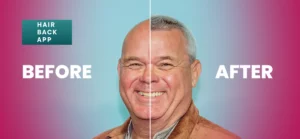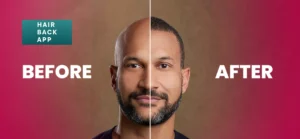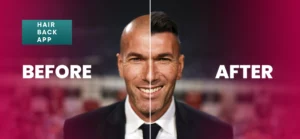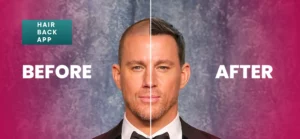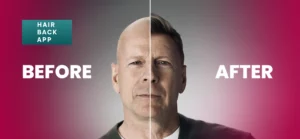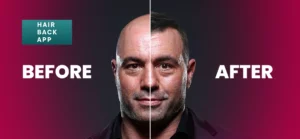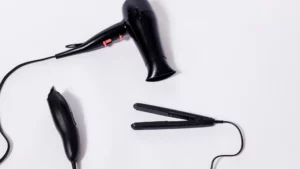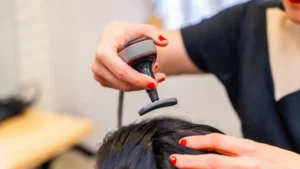Hair loss is a common concern for many individuals, with various factors contributing to its occurrence. One lesser-known form of hair loss is senescent alopecia, which can be particularly distressing due to its unique characteristics.
My name is Emma Wright, your resident hair restoration specialist. Today, we’ll be looking at senescent alopecia in detail.
In this comprehensive guide, we will delve into the details of senescent alopecia, exploring its causes, differences from other types of hair loss, and available treatment options. Let’s unravel the mysteries of senescent alopecia together.
What is Senescent Alopecia?
Senescent alopecia, also known as age-related hair loss, is a form of hair thinning and shedding that occurs naturally as individuals age. Unlike other types of hair loss, such as androgenetic alopecia (female or male pattern baldness), senescent alopecia is primarily attributed to the aging process itself rather than specific genetic factors or hormonal imbalances.
As people grow older, various changes occur in their bodies, including their hair follicles. These changes can lead to a reduction in hair density and diameter, resulting in noticeable thinning and loss of hair volume. Senescent alopecia typically manifests as a gradual and uniform thinning of hair across the scalp, rather than the distinct patterns seen in other types of hair loss.
The aging process affects the hair growth cycle, leading to shorter periods of active hair growth (anagen phase) and longer periods of resting (telogen phase). Additionally, factors such as reduced blood flow to the scalp, hormonal changes, and oxidative stress can contribute to senescent alopecia.
While senescent alopecia is a natural consequence of aging, it can still be distressing for individuals who experience it. Understanding the causes and characteristics of senescent alopecia is essential for effectively managing this condition and exploring available treatment options.
Senescent Alopecia Causes
Senescent alopecia, or age-related hair loss, is primarily caused by the natural aging process affecting the hair follicles.
Several factors contribute to the development of senescent alopecia:
- Aging of Hair Follicles: As individuals age, their hair follicles undergo structural and functional changes. These changes can disrupt the hair growth cycle, leading to a reduction in the duration of the growth phase (anagen) and an increase in the resting phase (telogen). Consequently, hair becomes thinner, shorter, and less abundant over time.
- Reduced Blood Flow to the Scalp: Aging is associated with a decline in blood circulation throughout the body, including the scalp. Diminished blood flow deprives hair follicles of essential nutrients and oxygen, impairing their ability to produce healthy hair.
- Hormonal Changes: Fluctuations in hormone levels occur naturally as individuals age. While senescent alopecia is not primarily driven by hormonal imbalances like androgenetic alopecia, changes in hormone levels can still play a role in hair thinning and loss, albeit to a lesser extent.
- Oxidative Stress: Oxidative stress occurs when there is an imbalance between the production of reactive oxygen species (ROS) and the body’s antioxidant defenses. Aging is associated with an accumulation of oxidative damage, which can negatively impact hair follicle function and contribute to hair loss.
- Genetic Predisposition: While senescent alopecia is primarily attributed to the aging process itself, genetic factors may predispose individuals to experience more severe or accelerated hair thinning as they age. These genetic predispositions can influence various aspects of hair follicle function and susceptibility to age-related changes.
- Environmental Factors: Exposure to environmental stressors such as pollution, ultraviolet (UV) radiation, and harsh chemicals in hair care products can exacerbate age-related hair loss. These factors can contribute to inflammation, oxidative damage, and disruption of normal hair growth processes.

What is the Difference Between Androgenetic Alopecia and Senescent Alopecia?
Androgenetic alopecia and senescent alopecia are two distinct types of hair loss, each with its own characteristics and underlying causes. Understanding the differences between these conditions is crucial for accurate diagnosis and effective management.
| Aspect | Androgenetic Alopecia | Senescent Alopecia |
| Causes | Primarily genetic and hormonal factors | Primarily attributed to aging process affecting hair follicles |
| Patterns of Hair Loss |
|
Uniform thinning across entire scalp (no distinct patterns) |
| Age of Onset | Typically starts in adulthood and progresses gradually | Typically occurs later in life, usually after age 50 or 60 |
| Treatment Approach | Focuses on hormonal regulation, hair growth promotion, and preventing further hair loss (e.g., minoxidil, finasteride, LLLT, hair transplant) | Focuses on holistic approach to hair care, scalp health, and minimizing age-related factors that exacerbate hair loss |
Senescent Alopecia Treatments
Treating senescent alopecia, or age-related hair loss, can be challenging due to its underlying cause being the aging process itself. However, several treatment options may help slow down the progression of hair loss and improve hair density and quality.
Here are some common treatments for senescent alopecia:
- Topical Minoxidil: Minoxidil is a topical medication that is applied directly to the scalp. It works by promoting hair growth and prolonging the hair growth cycle. Minoxidil is available over-the-counter in various strengths and formulations, and it is typically applied twice daily to the affected areas of the scalp.
- Oral Finasteride: Finasteride is an oral medication that inhibits the production of dihydrotestosterone (DHT), a hormone implicated in hair loss. It is commonly used to treat androgenetic alopecia but may also be beneficial for individuals experiencing senescent alopecia. Finasteride is available by prescription only and should be taken as directed by a healthcare professional.
- Low-Level Laser Therapy (LLLT): LLLT is a non-invasive treatment that uses low-level laser light to stimulate hair follicles and promote hair growth. It is thought to work by increasing blood flow to the scalp and energizing weakened hair follicles. LLLT can be administered using handheld devices or specialized laser caps and helmets, and treatment sessions typically last for several minutes, a few times per week.
- Platelet-Rich Plasma (PRP) Therapy: PRP therapy involves injecting concentrated platelets from the patient’s own blood into the scalp. Platelets contain growth factors that can stimulate hair follicle regeneration and promote hair growth. PRP therapy is performed in-office by a trained healthcare provider and typically requires multiple treatment sessions spaced several weeks apart.
- Hair Transplant Procedures: Hair transplant procedures, such as follicular unit extraction (FUE) or follicular unit transplantation (FUT), involve transplanting healthy hair follicles from donor areas to thinning or balding areas of the scalp. These surgical techniques can effectively restore hair density and improve the appearance of senescent alopecia. Hair transplant procedures should be performed by a qualified and experienced surgeon.
- Scalp Micropigmentation (SMP): SMP is a non-surgical cosmetic procedure that involves tattooing the scalp to create the illusion of thicker hair. It can be used to camouflage areas of thinning or baldness and enhance the overall appearance of the scalp. SMP is a safe and effective option for individuals looking to improve the aesthetic appearance of their hair loss.
- Hair Care and Lifestyle Modifications: In addition to medical treatments, maintaining a healthy lifestyle and adopting proper hair care practices can support overall scalp health and hair growth. This includes eating a balanced diet rich in essential nutrients, managing stress levels, avoiding harsh hair care products and treatments, and protecting the scalp from environmental damage.
Conclusion
In conclusion, senescent alopecia, or age-related hair loss, is a natural consequence of the aging process that affects many individuals as they grow older. While treating senescent alopecia can be challenging due to its underlying cause being the aging process itself, several treatment options are available to help slow down the progression of hair loss and improve hair density and quality.
From topical medications like minoxidil to oral medications such as finasteride, and from non-invasive treatments like low-level laser therapy (LLLT) to surgical procedures like hair transplants, there are various approaches to managing senescent alopecia. Additionally, scalp micropigmentation (SMP) and proper hair care practices can also contribute to improving the aesthetic appearance of age-related hair loss.
It’s essential for individuals experiencing senescent alopecia to consult with a qualified healthcare professional or hair loss specialist to determine the most appropriate treatment plan based on their individual needs and preferences. By taking proactive steps towards managing senescent alopecia and adopting a holistic approach to hair care and scalp health, individuals can maintain a full and healthy head of hair well into their golden years.
Ultimately, while senescent alopecia may be a natural part of the aging process, it doesn’t have to define one’s appearance or self-confidence. With the right combination of treatments and lifestyle modifications, individuals can embrace their natural hair with confidence and grace, allowing them to look and feel their best at any age.


